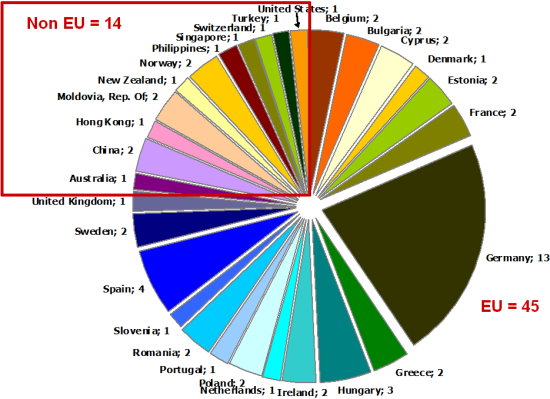A new study which benchmarks the abilities of laboratories around the world to measure heavy metals (arsenic, cadmium, lead, mercury, methylmercury and inorganic arsenic) in seafood has been published today by the Joint Research Centre. The outcome of the exercise was generally positive, with 80 to 96% of laboratories obtaining satisfactory scores, depending on the heavy metal considered. This result corroborates seafood consumers' protection in the EU, where the levels of lead, cadmium and total mercury are regulated by law.
Fifty-seven laboratories from 29 countries volunteered to put their measuring competence to the test. Each laboratory received a sample without knowing the levels of heavy metals present, and was asked to measure and report the values back to the JRC.
The good results should enhance consumers' confidence, as maximum levels of lead, cadmium and total mercury in seafood are regulated by EU law and it has been proven that most participants are able to correctly measure them. In addition, this comparison has highlighted other issues, such as the apparent dependency of the measurements of inorganic arsenic on the type of food tested.
Excessive intake of heavy metals may lead to a decline in mental, cognitive and physical health. A particular concern is potential developmental defects in children exposed in utero. From a toxicological point of view, the chemical form in which the metal is ingested plays a significant role. For example, methylmercury is much more toxic than inorganic mercury compounds, whilst inorganic arsenic is more toxic than the organic species of arsenic.
The interlaboratory comparison
The interlaboratory comparison was organised in support of the European Co-operation for Accreditation (EA), the Asia Pacific Laboratory Accreditation Cooperation (APLAC) and the national reference laboratories associated to the European Union Reference Laboratory for Heavy Metals in Feed and Food.
Participants were asked to report both the measured value of each heavy metal in question in the sample and the uncertainties associated with those measurements. The results were scored according to international standards.
The outcome of the exercise was generally positive. All of the 57 laboratories that registered reported results. The share of satisfactory scores ranged between 80% and 96% (Table 1 in the url link). Participants tended to underestimate the content of total arsenic, and to a lesser extent total cadmium. The distribution of the participating laboratories by country is shown in Figure

Figure 1: Distribution of participating laboratories by country, based on number of participants having submitted results.
Contrary to a previous exercise (IMEP-107 on total and inorganic arsenic in rice), the values reported for inorganic arsenic showed a large spread. Interestingly, this indicates that the matrix (in this case, seafood), has a major influence on the analytical determination of inorganic arsenic. This is a crucial consideration for legislators, because specifying single maximum level of arsenic in food would appear to be unfeasible.
Legislative situation
In Europe, maximum levels for lead, cadmium and total mercury in food are laid down in legislation, varying from 0.5 to 1.0 mg. per kg. for different seafood. No maximum level exists for the methylmercury form of mercury, as its measurement requires specific analytical equipment not routinely present in testing laboratories. However, methylmercury is the main source of human intake of mercury in fish and fishery products, and is important due to its high toxicity compared to inorganic mercury.
No maximum levels for arsenic have been laid down in European legislation either, due to a lack of information about reliable analytical methods for determining inorganic arsenic in different food commodities, and measurement values of inorganic arsenic are generally believed to be method-dependent.
The interlaboratory comparison was, therefore, extended to include methylmercury and inorganic arsenic, in order to investigate the issues that laboratories encounter in measuring these substances.
JRC-IRMM and the EU Reference Laboratories
The Institute for Reference Materials and Measurements (IRMM) is one of the seven institutes of the Joint Research Centre (JRC) which is a Directorate-General of the European Commission.
It operates four European Union Reference Laboratories (EU-RL), including the EU-RL for heavy metals in feed and food. The EU-RLs are analytical laboratories designated by EU legislation and which are an integral part of European risk management system. Their duties include setting up EU-wide standards for reliable testing methods, organising comparative tests, training analysts from national laboratories and providing scientific and technical assistance to the European Commission.
JRC-IRMM also operates the International Measurement Evaluation Programme (IMEP®). It organises interlaboratory comparisons in support to EU policies. Many of the interlaboratory comparisons are open to all laboratories that wish to participate, but some are restricted to, for example, national reference laboratories. Proficiency tests are normally carried out only on request of another Commission department or agency. Some comparisons are run to certify reference materials and validation studies are organised regularly to validate analysis methods.
Table: Summary of laboratories' performance measuring certain heavy metals in seafood
| Measurand | number of results returned | % of laboratories with satisfactory score |
| total cadmium | 52 | 96 % |
| total lead | 52 | 80 % |
| total mercury | 52 | 90 % |
| total arsenic | 47 | 89 % |
| inorganic arsenic | 12 | (no reference value could be established) |
| methylmercury | 9 | 89 % |
Further Information:
Ines Baer, Beatriz de la Calle, Inge Verbist, Hakan Emteborg, Piotr Robouch:
IMEP-30: Total arsenic, cadmium, lead, and mercury, as well as methylmercury and inorganic arsenic in seafood.
In: JRC Scientific an Technical Reports; EUR 24604 EN, 2010, DOI 10.2787/33057
Source: European Commission, Joint Research Centre, JRC
Last update: 26.11.2010
Perma link: https://www.internetchemistry.com/news/2010/nov10/heavy-metals-in-seafood.php
More chemistry: index | chemicals | lab equipment | job vacancies | sitemap
Internetchemistry: home | about | contact | imprint | privacy
© 1996 - 2023 Internetchemistry
